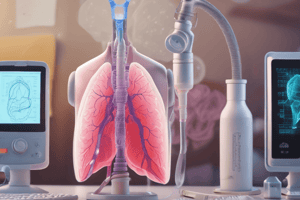Podcast
Questions and Answers
Which category of the Instrument Landing System (ILS) is most associated with providing precise lateral and vertical guidance during the final approach phase?
Which category of the Instrument Landing System (ILS) is most associated with providing precise lateral and vertical guidance during the final approach phase?
- Category I
- Category II
- Category IV
- Category III (correct)
What is the primary purpose of Traffic Flow Management (TFM) in air traffic control?
What is the primary purpose of Traffic Flow Management (TFM) in air traffic control?
- To optimize the efficiency of airspace utilization (correct)
- To schedule regular maintenance of aircraft
- To manage fuel consumption of aircraft
- To monitor weather conditions only
Which of the following best describes the Microwave Landing System (MLS)?
Which of the following best describes the Microwave Landing System (MLS)?
- A deprecated landing technology not suitable for modern aircraft
- A system that relies solely on visual aids for guidance
- An advanced navigation system using microwave signals (correct)
- A system providing only lateral guidance for landing
What do Standard Instrument Departures (SIDs) primarily facilitate?
What do Standard Instrument Departures (SIDs) primarily facilitate?
Which factor is NOT typically considered in environmental assessments related to air traffic control operations?
Which factor is NOT typically considered in environmental assessments related to air traffic control operations?
What is the critical difference between Category II and Category III ILS?
What is the critical difference between Category II and Category III ILS?
In Traffic Flow Management, what is the significance of implementing flow restrictions?
In Traffic Flow Management, what is the significance of implementing flow restrictions?
What is one of the main advantages of using mode S transponders concerning environmental considerations?
What is one of the main advantages of using mode S transponders concerning environmental considerations?
Which of the following statements about the microwave landing system (MLS) is accurate?
Which of the following statements about the microwave landing system (MLS) is accurate?
Which of the following elements is NOT part of the typical operational requirements for air traffic services?
Which of the following elements is NOT part of the typical operational requirements for air traffic services?
Flashcards are hidden until you start studying
Study Notes
Operational Requirements for Air Traffic Services (ATS)
- Expansion capability is essential to accommodate new equipment and administrative needs.
- Controllers must work in a safe, comfortable environment that protects against elements and provides adequate heating, ventilation, and air-conditioning if necessary.
- Sufficient dedicated power sources and outlets must be available for all existing and anticipated equipment, including radar and data automation systems.
- Critical equipment like radios and telephones should connect to an uninterruptible power supply to ensure reliability in operations.
- Backup power generators or two independent power sources are also required to maintain operations during outages.
- Ergonomics are important; chairs should be adjustable for height, strong, and provide proper back support to minimize physical discomfort.
- Noise reduction is critical for maintaining concentration, and the environment should be free from disturbances.
Control Tower Requirements
- Aerodrome control towers must allow air traffic controllers to visually monitor aircraft in the vicinity of the aerodrome.
- Window sills in control towers should be as low as feasible to enhance the controller's ability to scan the operational area.
- Tower consoles should not exceed the height of the window sills to avoid obstruction of views.
- The design of the tower should minimize vertical supports to reduce visual obstructions, even at the cost of potential reflections.
- The operational integrity of the ATS facilities relates directly to their functional suitability and comfort, reflecting public service standards.
Equipment and Infrastructure Needs
- Appropriate equipment improves controllers' visibility and communication capabilities with aircraft, colleagues, and other aviation authorities.
- Essential tools include lighting facilities, radios, and telephones, all of which contribute to effective air traffic management.
- Closed-circuit television and intercom systems offer advanced identification methods but can complicate operational duties if staff are required to monitor them.
- Excessive installation and maintenance costs for monitoring systems may detract from primary duties of ATS staff.
Appendices and Checklists
- Appendices include illustrations of aerodrome control tower designs, checklists for operations equipment, and specific operational and structural requirements tailored to the aerodrome environment.
- Structural integrity and layout considerations are crucial for the effective functioning of control towers and information centers.
Studying That Suits You
Use AI to generate personalized quizzes and flashcards to suit your learning preferences.




